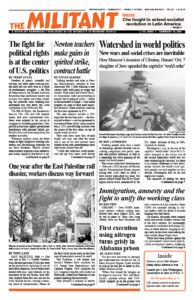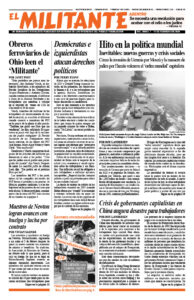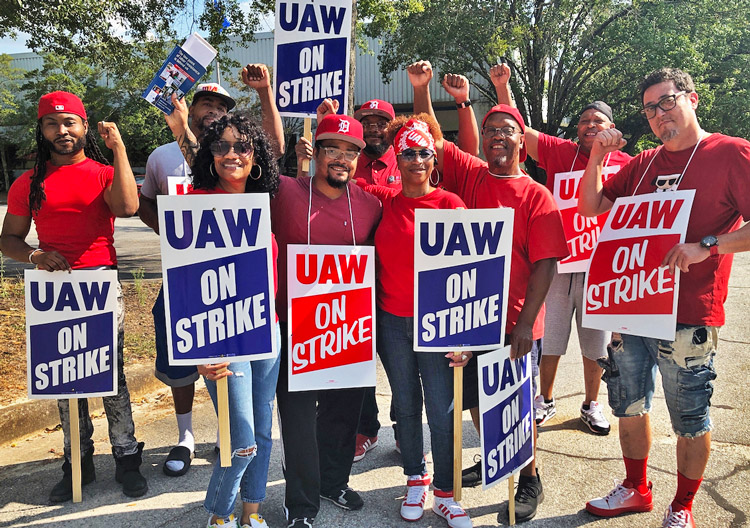The U.S. Labor Department reported last month that union membership dropped last year to 10%. At the same time, more workers are using unions to resist the employers’ assaults. As the Socialist Workers Party 2022 resolution explains, “The low point of labor resistance is behind us.” In these conditions, how can workers build, extend and strengthen unions and use union power to fight for the interests of all working people?
Union membership remained at 6% in the private sector, while in public-sector jobs it dropped from 33.1% to 32.5%, reflecting a decline in the number of state and local government workers. While the overall number of union members increased modestly by 139,000, there was an increase of 2.7 million mostly nonunion jobs in 2023.
The decline in the rate of union membership “contrasts sharply with growing evidence that Americans are on the side of labor unions,” says Lauren Kaori Gurley in the Washington Post. Last year was the most active for strikes in more than two decades, including strikes by autoworkers, Hollywood actors and writers and others.
Gurley concludes this discrepancy is a result of “how difficult it has become for American workers to join unions.” She cites comments by Heidi Shierholz, president of the Economic Policy Institute think-tank, who says, “Workers want unions, but a broken system is undermining their efforts to organize at every turn. Employers have exploited weaknesses in U.S. labor law, and federal and state policymakers have failed to prevent this from happening. It’s a long slog.”
But this is not why the percentage of union members has been falling since one in three were union members in 1947. Right-to-work laws that the bosses got passed in the years after World War II weakened the unions, but they didn’t stop workers looking for ways to join together to stand up for ourselves.
The reason for the decline of union membership since World War II is the top union officialdom’s increasing reliance on collaboration with the bosses who exploit us and on the capitalist parties that serve them. It was not a “long slog,” but an explosion of hard-fought battles in basic industry during the 1930s that forged powerful unions. Militant action by hundreds of thousands, including a powerful wave of sit-down strikes in 1936-37, that organized auto, steel, packinghouses, the docks, oil and other basic industries.
As workers began to sense their class power, many were attracted to organizing independently of the bosses’ political parties. But growing interest in establishing a labor party was opposed by union officials and the Communist Party, who did everything in their power to prevent workers breaking from reliance on Democratic President Franklin D. Roosevelt, who they touted as a “friend of labor.”
As the U.S. rulers entered the Second World War, most union officials subordinated workers’ class interests to Washington’s imperialist war aims, signing up to a no-strike pledge for the duration.
In the decades since, most union officials have increasingly subordinated workers’ interests to collaboration with bosses. They made the benefits workers could gain dependent on the profitability of the boss you worked for, rather than mobilizing the union ranks to rely on ourselves and to fight for what the working class needs as a whole.
Capitalism is not a “broken system,” but a system built on the exploitation of the working class. The root of our problems is not one or the other of the bosses’ Democratic or Republican parties.
“Our class enemy is the capitalists,” writes Jack Barnes, Socialist Workers Party national secretary, in Cuba and the Coming American Revolution.
“Under the conditions of imperialist ‘democracy’ that have prevailed in this country for more than a century, illusions in the two-party system remain the central political prop of capitalist rule in the United States,” Barnes says. “We have no common interests with the employing class. Everything they try to tell us about ‘our country,’ ‘our way of life,’ ‘our language,’ ‘our industry,’ ‘our factory’ are lies. The ‘our’ is the heart of the lie. It’s a diversion aimed at dividing us from those with whom we do have common interests — the workers, farmers, and exploited toilers of all countries.”
Today’s uptick in union battles shows that workers are looking for a road forward. During last year’s strikes, unions registered some gains in wages, benefits, livable schedules, and the fight against the ravages of inflation, and took on the divisions that bosses use to try to weaken unions.
Most importantly, workers gained confidence in themselves and their unions, and showed that solidarity can be won from fellow workers and across the labor movement. Participating in labor struggles and helping maximize union solidarity is crucial to scoring victories and is the starting point for organizing and strengthening unions.
There is no letup in the bosses’ offensive. They’re driving to hold down wages, push multitier contracts and impose speedup, forced overtime and “suicide shifts” that leave no time for family, rest, recreation, or union and social activity. The only check on their offensive against our class is our determination to fight back.
In the course of struggles against these assaults, more workers will see the need to break from the two bosses’ parties and to recognize we need a party of our own, a labor party based on the unions. On this road, a revolutionary leadership can be forged to organize workers in our millions to take political power from the capitalist class and into our own hands.


